Hyundai Motor Group Mempersembahkan Visi Mempopularkan Hidrogen
Hyundai Motor Group (The Group) untuk mencapai titik harga kenderaan fuel cell electric vehicle (FCEV) setanding dengan battery electric vehicle (BEV) menjelang 2030
The Group telah menetapkan visinya untuk tenaga hidrogen dan masyarakat hidrogen global.
Pada forum dalam talian global Hydrogen Wave yang diadakan hari ini, The Group menyampaikan rancangannya untuk mempopularkan hidrogen pada 2040 melalui pengenalan teknologi baharu dan penyelesaian mobiliti di sektor pengangkutan dan industri lain.

Lagi menggarisbawahi komitmen perintisnya untuk membersihkan tenaga lestari untuk semua jenis mobiliti, The Group melancarkan rancangan unprecedented yang akan menyaksikan elektrifikasi semua model kenderaan komersial baharu – yang menampilkan tenaga elektrik sel elektrik atau tenaga elektrik bateri, serta penerapan sistem sel bahan bakar – untuk semua model pada tahun 2028. Strategi yang berani akan meletakkan Ther Group di barisan depan sektor kenderaan komersial, dalam proses membantu membentuk semula industri dan mewujudkan masa depan yang bersih.
Mewakili rancangan The Group untuk ‘gelombang’ baharu produk dan teknologi berasaskan hidrogen yang memajukan perjalanan menuju masyarakat hidrogen, aktiviti Hydrogen Wave dimulakan hari ini dengan persembahan dalam talian – yang diketuai oleh Ketua Kumpulan, Euisun Chung, dan lain-lain eksekutif kanan. Pasukan ini menggariskan strategi hidrogen masa depan The Group untuk sistem sel bahan bakar dan penyelesaian berasaskan sel bahan bakar untuk mobiliti dan bidang lain.

Sasaran utama The Group untuk menerapkan barisan kenderaan komersilnya sepenuhnya dengan sel bahan bakar menjelang 2028 akan menjadikannya pembuat kereta global pertama yang mewujudkan cita-cita tersebut untuk pengangkutan kenderaan komersial dan seterusnya akan membantu mempermudah peralihan ke mobiliti lestari yang sebenarnya.
Sasaran utama The Group untuk menerapkan barisan kenderaan komersilnya sepenuhnya dengan sel bahan bakar menjelang 2028 akan menjadikannya pembuat kereta global pertama yang mewujudkan cita-cita tersebut untuk pengangkutan kenderaan komersial dan seterusnya akan membantu mempermudah peralihan ke mobiliti lestari yang sebenarnya.
Forum global dalam talian akan diikuti dengan pameran ‘HydroVILLE’ fizikal, di mana aplikasi dan konsep yang baru diperkenalkan akan dipersembahkan. Diilhamkan oleh potensi hidrogen bersih, pameran HydroVILLE menampilkan pelbagai konsep sel bahan bakar untuk mobiliti dan penjanaan kuasa masa depan.

Sejak pengembangan FCEV pertamanya pada tahun 1998, Kumpulan telah mempersiapkan masa depan hidrogen. Pada tahun 2013, Tucson FCEV (ix35 Fuel Cell) diperkenalkan, membuka pintu kepada pengeluaran besar-besaran FCEV. Kemudian, pada tahun 2018, syarikat melancarkan SUV sel bahan bakar generasi berikutnya, NEXO, dan trak sel bahan bakar tugas berat pertama di dunia, XCIENT Fuel Cell, pada tahun 2020.

Kini, The Group menyokong hidrogen untuk memainkan peranan penting dalam membangun masa depan yang lestari dan mengurangkan ketergantungan masyarakat terhadap bahan bakar fosil. Setelah dua dekad di barisan depan pengembangan teknologi sel bahan bakar, The Group akan memperluas teknologi sel bahan bakarnya untuk aplikasi kenderaannya yang lebih luas, termasuk penyelesaian mobiliti tambahan dan pelbagai penggunaan tenaga.
Menurut Majlis Hidrogen, inisiatif global kepimpinan CEO syarikat tenaga, pengangkutan, industri dan pelaburan terkemuka, tenaga hidrogen akan menyumbang 18 persen permintaan tenaga global pada tahun 2050, dengan saiz pasaran USD 2,5 triliun. Mempopularkan tenaga hidrogen juga akan membantu mengurangkan pelepasan CO2 lebih dari enam bilion tan setahun, sambil mewujudkan lebih dari 30 juta pekerjaan baharu.

Lagi dari kenyataan media Hyundai Motor Group.
MEDIA RELEASE
Hydrogen Vision 2040 – Carbon neutrality solution via an energy paradigm shift
The vision for Hyundai Motor Group is that by 2040 hydrogen energy will be used not only for transportation but will also be applied to wider areas of industries and sectors. The Group aims to make hydrogen energy available to ‘Everyone, Everything and Everywhere’.
During Hydrogen Wave, the Group is sharing its plans to proactively respond to climate change through hydrogen solutions, starting with the commercial vehicle sector, which emits larger amounts of CO2 and requires longer drive ranges’ compared with the passenger vehicle sector. As a result of such findings, the Group will launch all-new commercial vehicles such as buses and heavy-duty trucks for the global market as fuel cell electric vehicles and battery electric vehicles. By 2028, the company expects to become the first global automaker to apply its fuel cell system to all commercial vehicle models.
The Group has already started mass-producing a greatly improved version of the current XCIENT Fuel Cell, the world’s first mass produced fuel cell heavy-duty truck. It is also developing a tractor based on the XCIENT Fuel Cell that will be released in 2023. During Hydrogen Wave, the Group also unveiled the ‘Trailer Drone’ concept, a hydrogen-powered container transportation system capable of operating fully autonomously, with a double e-Bogie configuration.
Through the development of hydrogen commercial vehicles, the Group will promote the complete transition of Korea’s public transportation and logistics systems to hydrogen-based solutions – with a view to setting the benchmark for the world.
In addition, the Group will fully re-energize global commercial vehicle markets including Europe – which at present consists of 400,000 new units a year – through its advanced next-generation fuel cell technologies. The Group will develop a 5- to 7-meter fuel cell PBV (Purpose Built Vehicle) to target the global light commercial vehicle market projected for seven million unit sales per year by 2030. This will be in part undertaken by an expansion in its business capabilities and applying autonomous driving and robotics to the commercial vehicle sector.
Fuel cell systems are not only being used commercially for vehicles such as the NEXO SUV, Elec City Bus and XCIENT Fuel Cell truck, but also have the potential for deployment across diverse applications by 2040, including high-performance vehicles, urban air mobility, robots, aircrafts and large ships. As a result of such capabilities, the Group will expand the scope of fuel cell systems and technologies to all areas of the energy sector, including the provision of electricity and heating to buildings, urban energy sources and power plants.
To achieve this, the Group is planning to introduce a new generation fuel cell system in 2023 that realizes a reduced price and volume with significantly improved durability and output. Through ongoing R&D gains, engineering teams for the Group have been able to reduce fuel cell costs drastically over the last 20 years. By ensuring price competitiveness, the Group’s goal is to achieve a fuel cell vehicle price point comparable to a battery electric vehicle by 2030.
The Group will realize economies of scale of hydrogen production by continuous technological innovation of fuel cell systems as well as close collaboration with other organizations and governments across diverse business areas.
Next-generation fuel cell systems
It’s been an ongoing process for many years for the Group to strive to reduce the cost of fuel cell systems for mass application. In this process of continuous improvement, the Group has made great leaps in R&D and is presenting the results for the world to see.
During Hydrogen Wave, the Group presented a series of new fuel cell systems including a new prototype of its third-generation fuel cell stack – a higher-powered, efficiently packaged successor to the NEXO system – that is planned for market introduction in 2023.
Third-generation fuel cell system
Currently in development, the third-generation fuel cell stack will succeed NEXO’s current stack. At the event, the Group showcased two power versions of the third-generation fuel cell stack: 100kW and 200kW. The 100kW stack has reduced in size by an astounding 30 percent, making it 70 percent in size from the current generation stack to make it easier to apply to different vehicle types and applications. The 200kW version has been designed for commercial vehicle applications and is similar in size to the current NEXO system, but the power output has doubled.
For the second-generation fuel cell stack launched in 2018, the company achieved 5,000 hours and 160,000 kilometers of usage, which is similar to the warranty of an ICE vehicle. For the third-generation fuel cell development, the goal is to improve durability by 50-100 percent. High durability stacks for commercial vehicles will achieve 500,000 kilometers of drive range. Furthermore, the price of the third-generation fuel cell stack will be dramatically reduced – with projections being upwards of more than 50 percent – which will be the key factor to achieving cost parity of FCEVs with BEVs by 2030.
With flexibility and modularity at its core, the third-generation system can also be applied in various application forms. A new ‘Power Unit Module’ can offer a range of outputs from 500kW to 1MW by stacking 100kW modular units, ideal for use as an emergency power system for large ships or IT companies.
Also revealed at the event is an innovative fuel cell ‘Full-Flat System’ that lowers stack height to 25cm, allowing it to be used for various applications such as PBVs, MPVs, buses and trams by mounting the system to either the upper or lower body of the vehicle.
The future for hydrogen mobility
At Hydrogen Wave the Group presented its vision for future hydrogen mobility across several vehicle applications, from emergency relief and rescue, through to autonomous container transportation and high-performance sports cars.
Production, storage and transportation convenience will be important factors for the widespread application and the use of fuel cell technology. Under the Group’s dedicated HTWO brand for fuel cells, the Group is also unveiling new innovative concepts for portable, hydrogen refueling facilities.
Trailer Drone
The Trailer Drone concept is a hydrogen-powered container transportation system capable of operating fully autonomously. With the number of intelligently packaged hydrogen tanks tailored to the journey profile, the flexible and efficient Trailer Drone ensures more than 1,000km of sufficient range from a single charge, comparable to existing container transportation systems.
The autonomous capabilities of the Trailer Drone were not achieved by simply repurposing technology developed for passenger car applications. The unique requirements of container transport applications and the way container terminals operate meant that engineering teams from the Group needed to completely redefine how a container maneuvers. As a result, the engineering team developed the ‘Fuel Cell e-Bogie’.
Fuel Cell e-Bogie
The term ‘bogie’ originates from the rail industry. Rail bogies are wheel subframes that sit under every train car. The Fuel Cell e-Bogie sits under the container just like a rail bogie and is a fully enclosed system with fuel cell propulsion and fully independent four-wheel steering. The Trailer Drone concept requires two fuel cell e-Bogies, allowing for unprecedented maneuverability through sideways movement. The Trailer Drone can move autonomously through portside operations and tight urban environments. Efficiency is further boosted by the ‘Cluster Mode’ which enables multiple Trailer Drones to travel together in an almost train-like configuration.
The Fuel Cell e-Bogie is not exclusive to the Trailer Drone and caters to a wide value chain such as ground logistics, construction, firefighting and disaster relief missions. It offers a multi-purpose platform, capable of a variety of objectives – all in zero-emission and autonomous operation.
Vision FK
Fuel cell technology is equally applicable to high-performance vehicle applications. In this respect, the Group has showcased a concept hydrogen-powered hybrid sports car, named the Vision FK. With a maximum output of over 500kW, the Vision FK concept can accelerate from 0-100km/h in less than four seconds. Combining a fuel cell energy converter with a high-power, RWD, plug-in powertrain, the Vision FK aims to achieve over 600km in range.
Rescue Drone
The Rescue Drone is a new concept mobility solution that combines with a Fuel Cell e-Bogie to create a flying drone that can be operated remotely and autonomously for critical operations such as fire-fighting and life-saving. The Rescue Drone features an independent steering system for in-place turning maneuvers and ‘crab-walk’ driving. It can also carry out missions via images transmitted from drones mounted on the vehicle exterior and achieves a 450 to 500km driving range from a single charge.
H Moving Station
The H Moving Station is a heavy-duty vehicle equipped with charging facilities for FCEVs. This portable hydrogen refueling station ensures convenience as well as charging options in areas with limited hydrogen refueling stations.
RHGV (Rescue Hydrogen Generator Vehicle)
The RHGV supplies power to vehicles in aid of urgent assistance in remote, off-road areas. The portable electric vehicle charger offers single-phase 220V and 3-phase 380V simultaneous power supply.
Hydrogen Future: a new energy for a new society
As a responsible member of the global community, Hyundai Motor Group will continue to develop hydrogen mobility, expand the production system of fuel cells and establish infrastructures for a global hydrogen society.
“The degree and frequency of environmental disasters is rising fast and we now face a code red warning for humanity,” added Chairman Chung during the global online forum. “The Group seeks to offer powerful and pragmatic solutions for combatting climate change via the tremendous potential of hydrogen energy.”
HydroVILLE exhibition
Following today’s Hydrogen Wave online global forum, the Group will be presenting its plans for hydrogen energy and a global hydrogen society at its ‘Hydrogen Village’ (HydroVILLE) exhibition in Goyang, Korea, from September 8-11, 2021.
Inspired by the potential for clean hydrogen, HydroVILLE is divided into various zones to illustrate the Group’s future hydrogen vision. The exhibition space features several fuel cell concepts for future mobility and power generation, including 18 models from Hyundai Motor Group affiliates, including Hyundai Motor, Kia, Hyundai Mobis, Hyundai Rotem, Hyundai Steel, Hyundai Wia and Hyundai Kefico.
The table below outlines all mobility and fuel cell systems presented in today’s Hydrogen Wave online global forum:
| Name | Specification (Length x Width x Height) | Key Features |
| M.Vision POP | 2,600×1,644×1540mm | crab-drive and automatic parallel parking |
| M.Vision 2GO | 3,200×1,644×1600mm | |
| NEXO Minicar | 1,180×700×550mm | |
| XCIENT Fuel Cell | 9,745×2,550×3,730mm | |
| XCIENT Fuel Cell Tractor | 8,701×2,585×4,060mm | XCIENT Fuel Cell Truck (August, 2021 – July, 2022) |
| Fuel Cell Electric Tram | 21m×2.45m×3.4m | |
| Mobile Fuel Cell Generator | 2,850×1,550×1,225mm | |
| Hydrogen Fuel Cell Powerpacks (30kW and 50kW) | [30kW] 680 x 820 x 620mm [50kW] 852 x 1025 x 784mm |

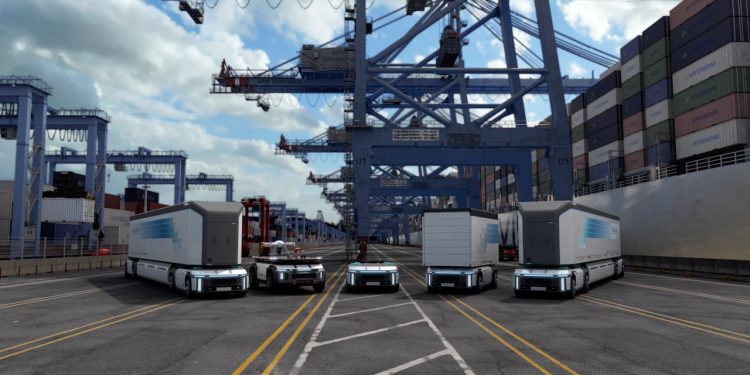
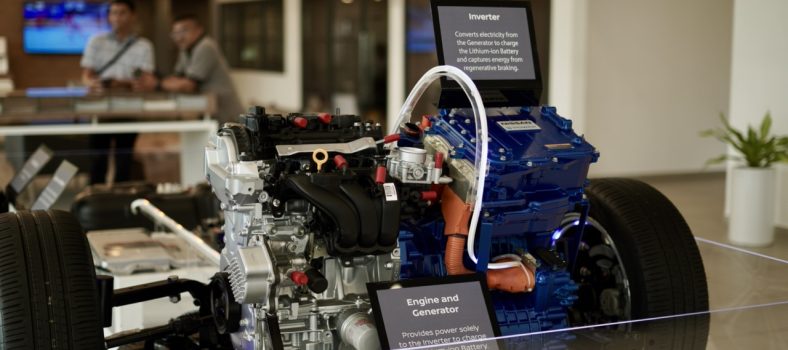
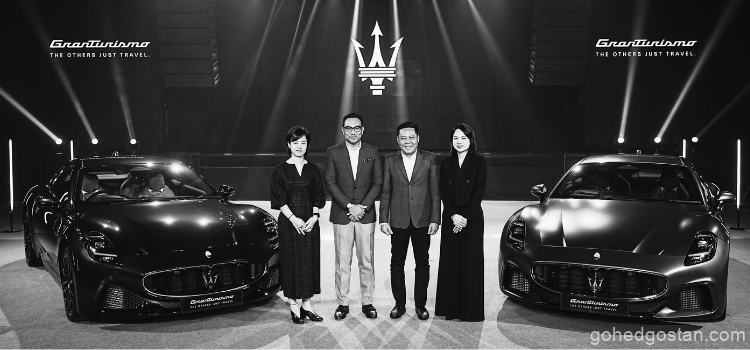
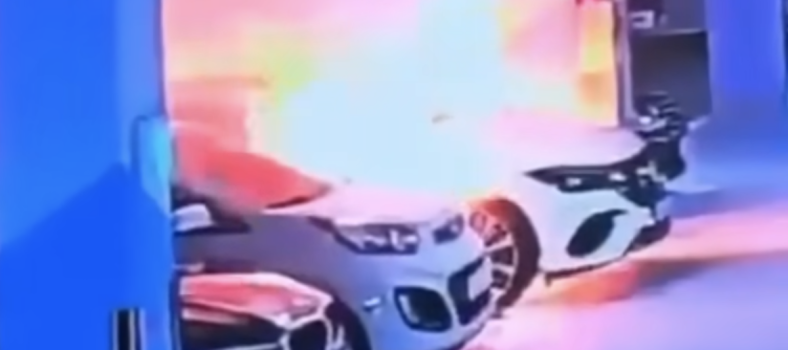
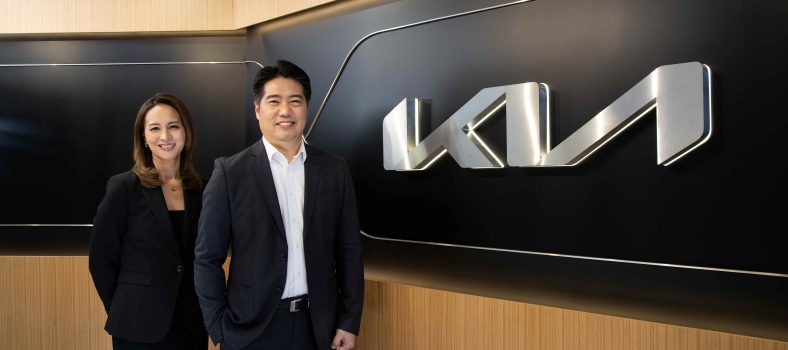
No Comment